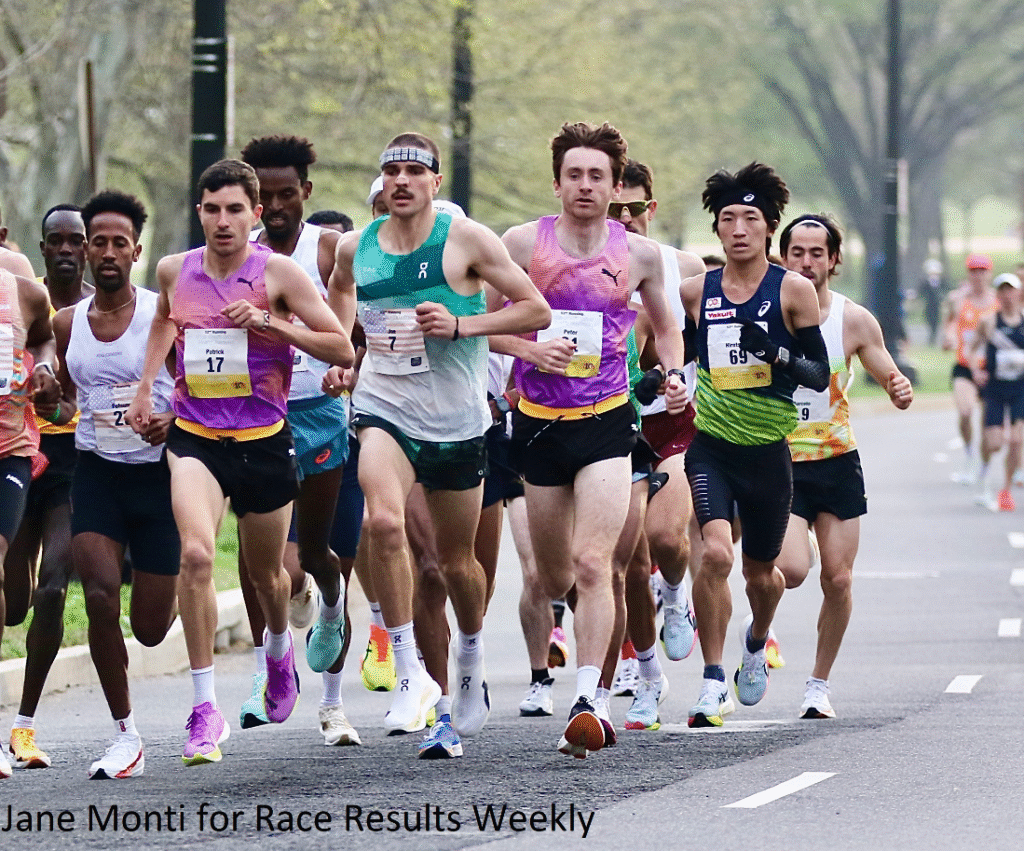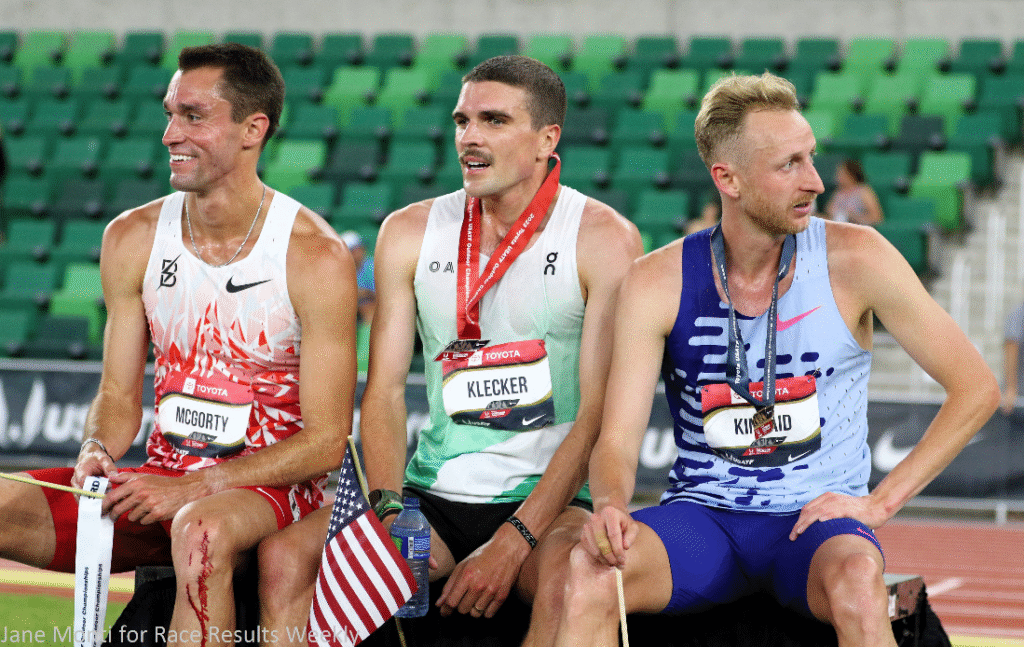By David Monti, @d9monti
(c) 2025 Race Results Weekly, all rights reserved
(18-Jun) – After a difficult year where an adductor injury forced him to be sidelined and miss the USA Olympic Team Trials and, by extension, the Paris Olympics, Joe Klecker has begun a new phase of his career where he is focused on road racing. The 28 year-old, who trains with the On Athletics Club in Boulder, Colo., had never run a road race longer than a mile until this January. But since the beginning of this year he has run five, highly-competitive road races and will do a sixth, the Boston 10-K, on Sunday. It’s a transition that he and coach Dathan Ritzenhein had planned for a while, even if the timing had changed.
“The big picture was always in the off-year after Tokyo (2025 World Championships), make that transition,” Klecker explained to Race Results Weekly in a telephone interview on Tuesday. “Then I got injured, pretty significantly, and we kind of thought that this might be the right time to push it up a year.”
Klecker had a complicated injury involving the intersection of his left adductor, a muscle on the inside of the thigh, and his abdominal muscles. He announced in May, 2024, that he could not make it to the starting line for the Trials where he had hoped to make his second Olympic team in the 10,000m. What he didn’t know at the time was that the injury would take the better part of a year to heal, and still lingered into January, 2025, when he made his half-marathon debut at the Aramco Half-Marathon in Houston.
“It was an interesting injury,” said the always-thoughtful Klecker. “I would say it lingered until about December, or January, around the time of Houston. I would say I was 90% healed, but it was the type of thing that after a hard effort, you’d still have some awareness of the injury. But, for the last three months, since February or March, it’s been completely gone.”
The Houston event was a road racing baptism by fire. It’s America’s fastest half-marathon, and on a cold morning the pack went out at 14:02 for the first 5-K and 28:01 for 10-K. That was too hot for Klecker whose splits were a more reasonable 14:13 and 28:38. He ran a very solid 1:01:06, but finished 18th, nearly two minutes behind the winner. It was at that moment that he realized that there was going to be a bigger learning curve than he thought to master the roads.
“The original plan was just to do Houston and then go into a track season,” Klecker said. “But once I did Houston I just kind of saw the level that the roads were at. I was like, wow, this is going to be a bigger transition than I thought.” He added: “Those guys were ripping.”
Ritzenhein was on the same page.
“That injury he had in spring of ’24 was tough to miss out on his second Olympic team,” Ritzenhein told Race Results Weekly in a text message. “But I’m amazed how dedicated he was to the transition to the roads after that. It’s been a longer process than we thought.”
Klecker decided to do another half-marathon in early March, the USATF Half-Marathon Championships in Atlanta. That was a completely different kind of race, held on a hilly course with a lot of turns and with no pacemakers. He ran a similar time, 1:01:34, but had a better competitive experience.
“That one I was ready for the punches, early,” said Klecker, who finished eighth in an all-American field. “That one, Hillary Bor really fartleked that race. We took it out in about a 4:20 mile, and we were running very fast for the first, eight to ten miles of that course. We were just ripping.” He continued: “I was very proud of a lot of stuff in that race. It was very close to being a great day. It was just around ten miles that I lost the pack.”
But Klecker was getting more comfortable racing in 40mm stack-height road shoes and managing the varied terrain and surges of road racing. When he went into the Credit Union Cherry Blossom 10-Miler in Washington, D.C., on April 6 (another USATF Championships), he was ready for the hard, early miles. He was with the leaders at 5-K in a very fast 13:58, and just a few seconds back at 10-K in 28:12, effectively setting a new road PB for that distance.
But the course has several sharp turns, including a 180-degree turnaround after the 10-K mark. Klecker fell back on those turns forcing him to surge in order to catch up, using valuable energy. He finished ninth in 46:08. More lessons were learned.
“I learned a lot from that one,” Klecker said. “I knew it was going to be fast and I wanted to kind of sit in the pack, but… there are a lot of turns. If you sit in the back of the pack, a pack of like ten people, can really string out around these turns. And then you really have to work hard to bring it back together. With how fast the pace was I was really putting in a lot of energy every turn.”
With plenty of miles in his legs and all of the learning from the first three races, Klecker put together his best road race at the USATF 25-K Championships in Grand Rapids, Mich., on May 10. He not only wanted to win that race, but also wanted to use the race as a marathon simulation because, in practical terms, 25 kilometers is the longest an athlete can race in the United States without doing the full marathon distance.
Competing against Casey Clinger and Hillary Bor, the trio split the half-marathon in 1:01:14, essentially the time he ran in Houston back in January, but now he had another four kilometers to run.
“I was leading for probably 14 miles,” Klecker recounted. “I didn’t have so much of a plan, but during the race I know Hillary would probably want to throw in some surges. To kind of play the mental game, whenever he tried to throw in a surge I would counter with my own surge. I could sense him getting a little bit frustrated during that race, which is some of the fun aspect of the battle that we had.”
Clinger set a national record of 1:12:17 to get the win, and Klecker finished second in 1:12:32, also well under the previous national record. Things were starting to click for Klecker.
“I was actually able to feel like I was racing, versus trying just to hang on to a pack, which is how it felt in Atlanta and at Cherry Blossom,” Klecker said. “I was really just reacting and trying to hang on, versus really feeling like I’m breaking my competitors, or trying to break them with moves and surges. It’s really empowering.”
As a former University of Colorado Buffalo, Klecker thought it was important to run the high-altitude Bolder Boulder 10-K on Memorial Day, even though it was only 16 days after the Grand Rapids race. His legs were not fully recovered, but it was thrilling to enter a packed football stadium where the race finishes. He placed a solid sixth in 29:13.
“After Grand Rapids Dathan came up to me and said, look, this is going to take a lot out of you,” Klecker recounted. “We really need to think if we’re going to do Bolder Boulder still. It’s so hard to pass up a race of that caliber which is literally a ten minute drive from my house.”
Klecker passed up the USATF 4-Mile Championships last Saturday in Peoria, Ill., so he could be fully rested and prepared for Sunday’s 10-K in Boston. He’s looking forward to a high level of competition, but also a mostly-flat, sea level course.
“Dathan always says that the number of miles the race is, that’s how many days it takes until you start feeling good again,” Klecker said. He continued: “We took the 4-mile championship off the calendar so that we made sure we got in three weeks of good training. Last week we started resting-up, then this week more rest. I told Dathan going into this one I want to make sure I’m on fresh legs.”
From Boston, Klecker may be headed back to the track. Or not. He’s eyeing the 10,000m which will be held at the Prefontaine Classic on July 5th as a possible return to the track (the race will be the Kenyan Trials for the World Championships). If he runs there and has a great day, he might do the USATF Track and Field Championships at the end of July and try for a team spot for Tokyo.
Maybe.
“I’m not holding too firm to any plans because my most important race is always my next race,” Klecker said. “Tentatively, I want to run the 10-K at Pre and see how that goes, then maybe put a 5-K on the calendar.” He continued: “Depending on what I run at Pre, if I run 27:10, no. If I run 27-flat, maybe. But I think the faster I run at Pre that would set the gauge for do I want to run at the Trials and try to make Tokyo. It’s not the focus that it was in years past.”
For the fall, Klecker is keeping his options open. He might make a marathon debut, or do a slate of shorter road races. Moving up to the marathon is the main goal, but he and Coach Ritzenhein are flexible on the timing, and on the specific race.
“Since Grand Rapids went really well, we’ll consider one this fall,” said Klecker. “We haven’t committed to anything yet, but it’s definitely on the table to do a debut this fall.” He continued: “I think getting the experience earlier is very valuable. That’s kind of what Grand Rapids showed me, that everything with the training is trending in that direction.”
PHOTO: Joe Klecker (center) after taking second in the 10,000m at the 2023 USATF Track & Field Championships in Eugene, Ore. (photo by Jane Monti for Race Results Weekly)
PHOTO: Joe Klecker competing at the 2025 Credit Union Cherry Blossom 10-Mile in Washington, D.C. (photo by Jane Monti for Race Results Weekly)
Klecker_CUCB_Mile_1_2025_Jane_Monti_With_Credit.jpg

Kincaid_Klecker_McGorty_Podium_10,000m_USATF_Champs_2023_July_06_Jane_Monti_With_Credit.jpg

